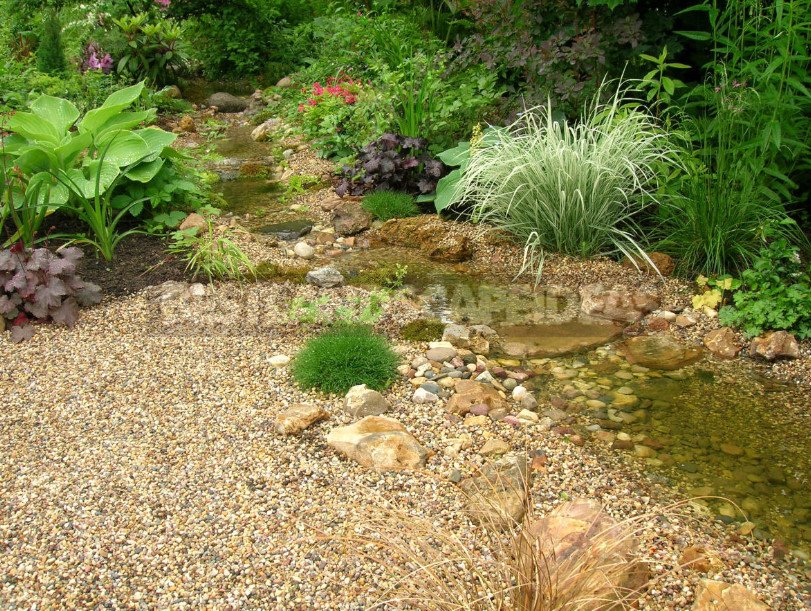
Readers have come a long way with us from studying the most common mistakes that are allowed in the construction of reservoirs, to the rules of creating a pond in a natural style. Continuing the theme will be especially interesting for those gardeners who prefer calm water, but its movement and sound.
What is good about the Creek
Take my word for it: the stream makes a very unusual impression and is spectacular in a garden of any size, but especially good in a garden of landscape style.
Its width and depth are usually small, but the length is important. The most natural way the stream flows where there is a height difference, but you can arrange it on a level plot. There are many variants of the composition: you can accentuate the source, that is, the highest point, but you can – the mouth, where the stream flows into a pond, and you can not do either one or the other. These key technological points of the artistic composition can be deliberately excluded and admire just the flow, and where and where it flows, will remain a mystery. You can organize the stream channel that will make it look like it goes into the sand.
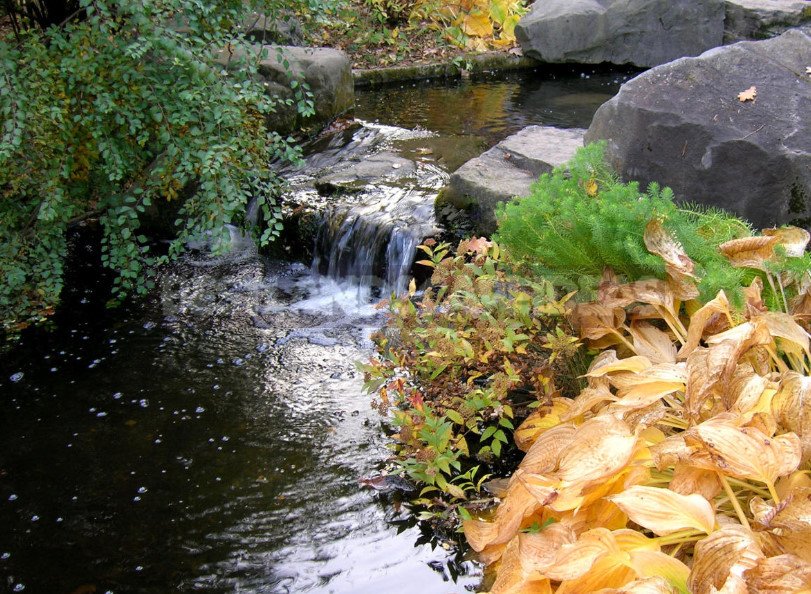
The number of thresholds — that is, height differences-will depend on the length of the stream. The longer it is, the more justified will be a large number of rifts. And there can be three, seven and so on. If we are talking about a strongly pronounced relief, it makes sense to arrange not a stream, but a small waterfall or even a cascade of waterfalls. All these options are different images of moving water.
The choice, of course, should be determined by the characteristics of the site. In any case, we should not forget that the movement of water is always accompanied by sound, it is often overlooked. And in vain: in a small area the noise of the turbulent flow can interfere, especially at night.
The choice of style and image flow
Whichever variant of moving water you choose, the principle of action will be the same: looped water. It is supplied by a hose from the lower reservoir-drive (it can be a pond, and can be just dug into the ground and a decorated barrel) with a pump to the upper point of the stream bed (waterfall, cascade) and from there under pressure or gravity flows, overcoming thresholds, back to the drive.
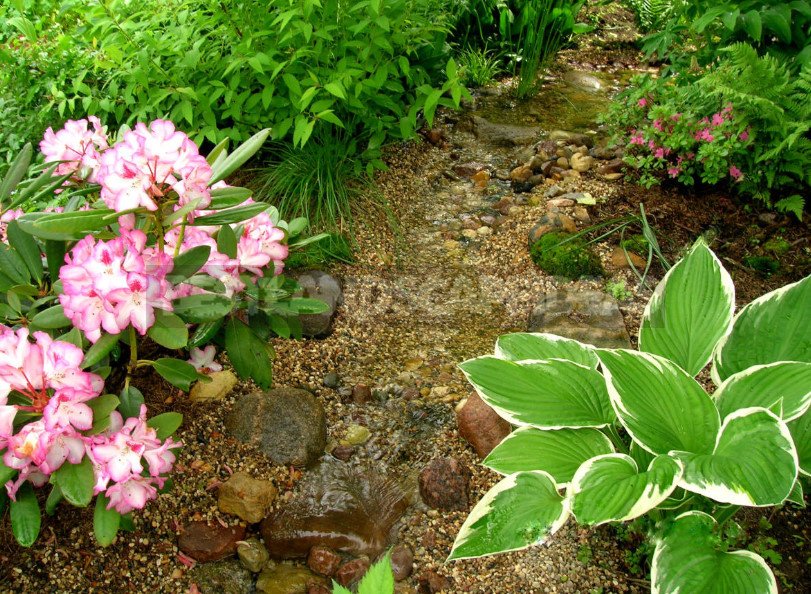
All the time the same volume of water circulates, so all the links in the chain should be arranged in such a way that the water is not spent on the side, otherwise you will have to constantly pour it into the drive. Therefore, the longer the stream, the higher the thresholds and the greater their number, the greater the volume of water must initially be in the storage and, accordingly, the greater the power needed pump.
In order to avoid unnecessary hassle and mistakes (they are better to avoid than correct), it is important to develop a project at the preparatory stage (sketch, drawing in scale, top view and section view) in relation to a specific site, taking into account the artistic and stylistic decision of the garden.
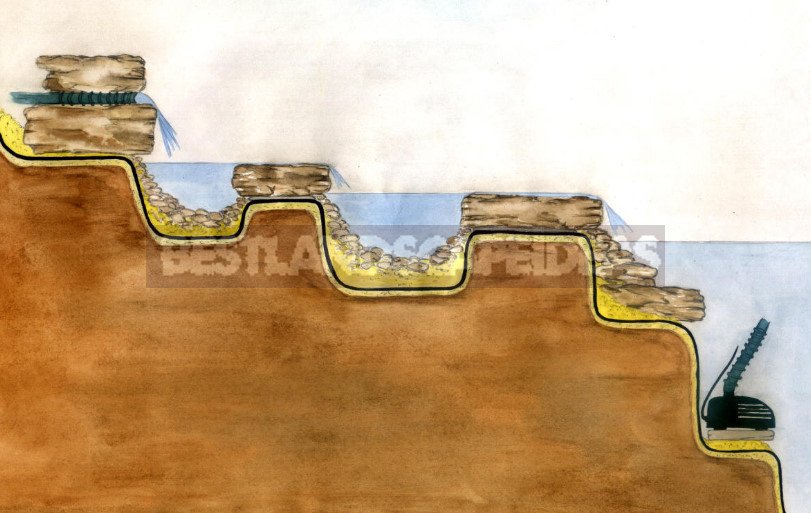
Materials for arrangement of the garden stream
The choice of materials and technologies should be justified and rational. And before the start of work all the necessary materials should be in place.
What can we need to perform a garden stream in the image of natural?
1. Of course, PVC film. We are quite satisfied with the thickness of the section 0.5 mm or 0.8 mm, black, it can be cut and glued with a special glue, it is more convenient to work with it in warm, dry weather.
2. A special submersible pump, which we will place in the lower storage tank.
3. Special hose for pond pumps section (depending on situation) ½, ¾, 1 or 1 ½ inches. The hose section is determined by the length and the required flow capacity. As we have already said, the water can barely rustle on the stones, and can rapidly wide veil “roll” through the rapids. With a long channel, there will be a loss of friction power when water passes through the hose.
4. We will also need sand or geotextile as the underlying and cushioning material and stone for decoration.
The choice of the latter will be determined by the stylistic decision. For elegant brook suitable small and not very large stones: gravel, pebbles, river and lake boulders in the cold or warm colors. For the waterfall and cascade will need more serious stones: medium and large blocks with character, with a ragged structure, usually in the cold range.
5. We will definitely need some water-loving plants for planting near the Creek and in the channel itself. Their species and varietal diversity, again, is determined by the artistic image of the flow.
Particular attention should be paid to the choice of material for the storage tank. Your artistic idea will determine the technology and, accordingly, the rational material.
Ground works
Let’s build a long, slightly winding stream on a slightly pronounced relief. It originates from a key in the depths of the shady part of the garden, gliding between Spiraea, Rhododendron and Tracheophyta under the canopy of Acer and Aralia. In some place goes to an open area and eventually flows into a small round pond, in which there are no large aquatic plants, but only deep oxygenators, but live fish, frogs and newts. The absence of a large number of plants in the pond is explained by the fact that at small sizes (diameter slightly more than 2 m), it is surrounded by classical garden plants, and in General the composition is quite saturated with details.

So, we chose the place of the future stream, drew its configuration and start the soil works. Our task is not only to dig the channel, but also to structure the height differences that will determine the levels of the stream.
To implement our idea is quite suitable trench depth of 20-25 cm, width and length according to the project. In some place, the width may vary, somewhere you can arrange a kind of dam, but it is easier and cheaper to perform a stream of the same width along the entire length of the channel. Visually complicate it can be due to rolls, bends, the inclusion of large stones in the composition and the use of other techniques.
Digging a trench, it is advisable to leave small dirt mounds-they will later become a support for stones in the shallows and will not allow water to flow completely from the stream during the pump shutdown. The places of such points are determined by the project and can be compositionally tied to the bends of the channel. If the project provides for a sharp turn, it is better to place it on an even place without rollovers.
Once the basic ground work done, you need to stamp the bottom, wall and the edge of the bed. If the soil in the immediate vicinity of the future coast is too porous (light, loose), it is better to replace it with a heavier, clay to avoid the possible capillary effect of the soil. If you do not, in the future there may be a serious loss of water, especially if the stream is long. Before laying the film, around the bed of the stream should pour a small layer of sand or use geotextiles.
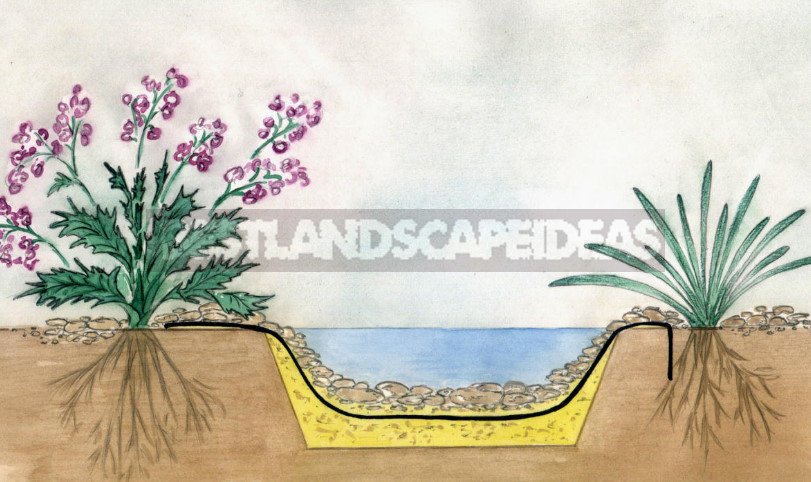
Pre-heated and softened in the sun roll the film in a convenient way and place in the upper point of the channel, leaving enough to decorate the source of the edge. Roll out and gently lay the tape across the channel, forming curves, creating folds. To film in the process does not move, it can be pressed down in several places with stones. The lower edge of the film should be free to fall into the storage tank. If it is a film pond, it is possible to glue a place of a joint by means of glue. Whichever option you choose, you need to carefully arrange the place of discharge of the stream so that the water does not go beyond the drive.
On the spread film again pour a layer of sand or lay geotextile. They will, on the one hand, protect the film from damage, on the other hand-will serve as a support for decorating materials: pebbles, gravel, etc.

Keep in mind that the same size bulk material, such as fine gravel, will inevitably crumble from the sloping surfaces. Here it is better to use a material of different fractions: coarse sand, gravel, gravel the size of a plum, with the inclusion of individual stones larger. Different-sized stones will “help” each other to stay on the sloping surfaces.
With special attention it is necessary to pick up key stones, that is those which will go for finishing of a source, a mouth, for registration of places of rifts, that is spillways stones. As a rule, they should be wide and flat, have a beautiful structure and strength. For example, some shales and sandstones can quickly collapse. With constant humidity, this process will go faster.

For many, the financial issue in the selection of stones is crucial. It is clear that the stone-the most expendable thing in the whole venture. But it is not necessary to choose the most fashionable and expensive breeds, just approach this issue creatively. You can work with local, cheap breeds. It is important to consider the composition, skillfully group the stones of different sizes and guess the preferred tone: cold, warm or white, dark or light. Keep in mind that the choice of color greatly affects the artistry.
To be continued…

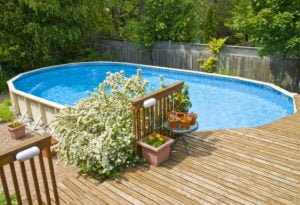
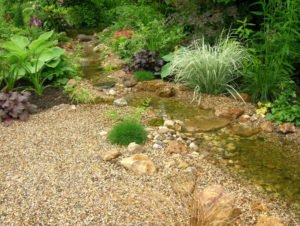

Leave a Reply